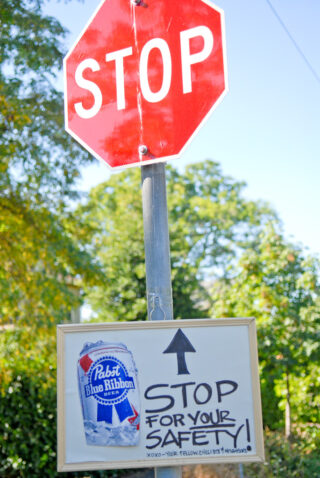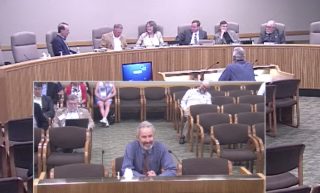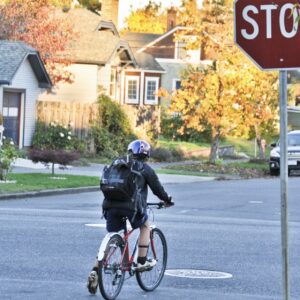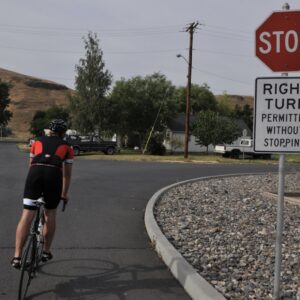
It’s not the Idaho Stop, but a law that would allow bicycle users to treat stop signs and flashing red signals as yields (when safe, of course) would be a major step forward for bicycle users in Oregon. And it just moved one major step closer to passage as the 2019 session rolls into its final few weeks.
Senate Bill 998 passed the Senate Rules Committee yesterday by a vote of 4-1. This comes two months after it passed the Senate Judiciary Committee.
Lane County Senator Floyd Prozanski — who introduced a bill inspired by Idaho’s law in 2003 — was the sole person to testify at the committee hearing yesterday. “What Idaho has is much broader than what’s been introduced here, he explained to the committee. “It [Idaho’s law] also allows bicycle riders to do the same [yield] at red lights. I believe that’s too far to go at this stage and that’s why we should follow what would be more the Delaware model.”
Delaware passed their law, which they call the “Delaware yield”, in 2017.
According to Prozanski, the main benefit of this law is that it would allow people on bicycles to maintain momentum at intersections and therefore be less likely to suffer from a collision or close-call. When bicycle riders come to a complete stop, the act of starting up again can make them vulnerable to being hit by other road users who can increase speed more quickly and easily.
Only two of the five senators on the committee made a comment before filing their vote. Republican Sen. Herman Baertschiger (Grants Pass) voted in favor of the bill. “If you want to ride your bicycle through a stop sign; very good,” he said, “But I would strongly suggest if you’re riding around the capitol today with all these log trucks [being driven around in protest of Oregon’s pending climate legislation], today wouldn’t be good day to do it.” Then everyone laughed.
Advertisement

(Screenshot from Oregon Legislative Information System website)
Committee Chair Senator Ginny Burdick said she feels the bill will be a boon for riders who click into their pedals with cleats. Removing feet from cleats at every stop sign can “sometimes be dangerous for those of us who are not particularly skilled,” she said; then added, “I will also point out that if anyone messes up it’s the bicyclist that pays the price, not the driver.”
Prozanski told his colleagues an additional benefit of the bill would be that more bicycle riders would stay away from more heavily congested streets and opt for residential ones if they knew they treat stop signs as yields.
Sen. Brian Boquist (R-Dallas) was the sole no vote. He didn’t explain why.
To clarify what SB 998 would do, below is the description taken from the official summary published by the Senate Rules Committee:
Senate Bill 998 A allows a bicyclist approaching an intersection regulated by a stop sign or flashing red light at a safe speed to proceed through that intersection or make a turn without stopping. It also creates traffic violation of improper entry into an intersection controlled by a stop sign and improper entry into an intersection controlled by a flashing red light. A violation of either occurs when a bicyclist fails to yield to traffic within the intersection or to traffic that is approaching so close as to constitute an immediate hazard, disobeys a police officer or flagger, fails to exercise care to avoid an accident, or fails to yield the right of way to a pedestrian. SB 998 A makes a violation of either a Class D traffic violation.
This is the third time Oregon has tried to pass a bill like this. Prozanski’s first attempt failed in 2003. Advocates tried again in 2009 but it didn’t have enough support.
From here the bill will move to the Senate floor for a vote. Assuming it passes it would then be referred to the House Rules Committee before it could advance to the House floor. Once it moves to the House, it will be imperative for supporters of the bill to make their voices heard. The end of the 2019 session is constitutionally set for June 30th, but there are rumors it could end even sooner.
Timing will be key. Hopefully the bill can keep moving through the process without coming to a complete stop.
In other legislative news, SB 558 — the bill that would allow any city in Oregon to reduce the speed limit on residential streets by 5 mph — is nearing a final vote in the House.
— Jonathan Maus: (503) 706-8804, @jonathan_maus on Twitter and jonathan@bikeportland.org
Never miss a story. Sign-up for the daily BP Headlines email.
BikePortland needs your support.






Thanks for reading.
BikePortland has served this community with independent community journalism since 2005. We rely on subscriptions from readers like you to survive. Your financial support is vital in keeping this valuable resource alive and well.
Please subscribe today to strengthen and expand our work.
Well this all sounds fine and dandy… Experience has taught me to be careful what you ask for because you might just get it.
A few people will use this responsibly. The great majority will keep on keeping on, doing whatever they are doing now…
But, since I’m a contrary guy, some minor number of folks are going to interpret this as “Bike riders can completely ignore stop signs and red lights now!”
Many tears will follow…
@Brian, we know what will happen because we have literally decades of data from Idaho. There was no change in the injury or fatality rates as a result of the move to allow cyclists to treat stop signs as yield signs. There will be no tears, although there may be some cheers as folks will no longer be given tickets for rolling through stop signs on residential streets when no other vehicles or people are present, which is a regular occurrence in portland.
came up on a stop sign the other day. Used a signal. Stopped. proceeded to turn right. Had I not been paying attention (and expecting the bike to be clueless) they’d be in the hospital. They didn’t even slow down for the stop sign. Then proceeded to yell at me for almost hitting him.
You saw a bike riding itself through a stop sign? And then the bike yelled at you?
Joke: if a bike yelled, would the bicycle yell in the predominant language of the country in which it (he? she? they?) was assembled?
Someone needs to tell the chump who blew through a stop sign in front of me (and several other cars) that this is not yet a law.
One bad cyclist makes the rest look bad.
Stopped at a red light this morning. Light turned green. I didn’t go immediately because a driver blew through the red at 30MPH a moment later.
Does one bad driver make the rest look bad? Or are you just looking for an excuse for your prejudice against people riding bicycles?
(Note: helmet cam video available if you want. Driver eastbound on Lovejoy at NW 9th.)
It won’t matter. MOTRG thinks bikes are, like, the exact same thing as cars, and just as dangerous to others. I can only extrapolate that he feels the same way about pedestrians.
I just think we should all obey the laws equally. Is that so radical an idea?
In a city with extremely limited traffic enforcement resources, we have no time to worry about cyclists not coming to a complete stop after arriving at an empty intersection. Doing so is wasteful at best, and biased at worst. Our resources should be applied towards saving lives, not trying to apply ‘equal laws to all road users, regardless of mode’, in some sort of shallow crusade for what you perceive as ‘fairness’.
It’s not a radical idea – it’s just a stupid idea. Cars and bikes are NOT equal – not according to the laws of physics, and therefore should NOT be treated equally.
I do agree with the idea that all road users should know what to expect from other road users. But for way too long motorists have used laws designed for automobiles to lambast cyclists, and you, MOTRG, are part of that proud tradition.
But you also apparently believe, “One bad cyclist makes the rest look bad”.
Dan, I don’t have a prejudice against cyclists – I just don’t have a bias FOR cyclists. Surely you can understand that.
Do you think I don’t ride?
So then do you believe, “One bad driver makes the rest look bad”?
And someone needs to explain again for the n + mth time, that even if the pending bill were the law, the so-called counterexamples being given here would still be illegal. This bill does NOT legalize “blowing” through STOP signs without due care, and in fact creates an entirely new class D traffic violation (apparently applicable only to bicyclists) of “improper entry into an intersection controlled by a STOP sign”.
Here’s my guess:
A) People who exhibit the behavior so feared and reviled by all—“blowing” STOP signs—likely do so now because they misunderstand the law, or don’t care. Passing a new law will not suddenly cause them to understand the law or care: Their behavior will not change, and will still be subject to citation and fines.
B) People who currently either stop at or cautiously roll through STOP signs likely do so now because they believe it is the safest way to proceed. Passing this law will not suddenly change their perception of what is safe: Their behavior will not change, but will no longer be subject to citation and fines.
Conclusion: NO ONE’S behavior is likely to change as a result of passing this law (if it passes), AND the amended law would narrow the focus of traffic enforcement to continue to allow police to cite and fine those who operate dangerously, while NOT citing or fining those who operate safely.
IF we accept that—human nature being what it is—the behavior of bicyclists is unlikely to change (maybe not everyone accepts this), why do so many of these comments sound like we want to continue to support the ticketing of bicyclists who operate safely?
Here’s a thought – obey the laws as they are written. It’s not that challenging.
Uh-oh…what if they re-write the law? Which is right? The old law, or the new one?
I know, I know—it’s not about what’s “right” it’s about what everybody can agree on. Sort of like when we all agree that speed limits really mean one can drive at least 10 mph faster than the written law, or that drivers don’t really have to stop before making a right on red, or that bicyclists must always ride on the outside of whatever white line may or may not be painted on the edge of the road, or any number of things that we all “agree” upon, or at least expect from each other—“written” or not.
With regard to this specific law, do people expect something different from what currently tends to happen at intersections? What I see currently happen at intersections is that almost no one—drivers, bicyclists, pedestrians, skaters, scooters—comes to a complete stop at a STOP sign. To a person, operators of any vehicle will slow to what they believe is a “safe” speed for long enough to assess the situation, then either stop if they see someone else proceeding (or if the intersection is heavily populated), or roll on through if the way is reasonably clear. Yes, there are the occasional cases where somebody will proceed in an unexpected manner, but does that not happen everywhere, all the time?
“Read all about it! Law Changes Nothing—Confusion Reigns! —Citizens furious that innocuous behavior now ‘un-punishable’”
I don’t like to say it, but “only in Portland”.
If only there were like, 37 years of data from Idaho, one might be able to guess what might happen.
Who knows?
[shrug]
I’m from Boise (hope to go back soon). This is no bid deal there. As an issue it is completely ignored by everybody. Portland seems to be stressed and glum about nearly everything. Maybe thoughts of the Big One are keeping everyone on edge?
We have to figure out a way to pretend that we are inventing something new. Like, who could possibly imagine that mountain bikers could travel on the same trails as hikers?? It sounds impossible. We’d better do a 20-year study.
What nobody will say is, generally people riding who are confident, don’t stop for unpopulated intersections. Neither do cars, but since they are immune, that’s a non issue apparently. Stop signs are designed for, meant for….vehicles. not people walking or on bikes. In addition, stop signs are stupid and serve no purpose that a good sign would not. But we are America and therefore into redundancy. And since stop sign tickets are lucrative, they will stay around.
Say, isn’t there still a stop sign at 39th and glisan and a roundabout?
That’s no roundabout, that’s a regular stop at a ‘T’ intersection, but the top part of the T is curved.
A bike going 20 miles an hour is a vehicle…..
A bike sitting in my garage is a vehicle. I think Mark Smith meant to say, “motor</em. vehicles", from which it is much, much more difficult to see or hear what is going on at an intersection than it is from a bike.
If you are implying that bicyclists will suddenly feel entitled to blast at 20 mph through STOP signs without so much as looking or attempting to slow down, I think that will only happen in minds of people who perceive bicyclists as children.
A person running with shoes at 11 mph is a vehicle?
Complex systems (more than one operator) generally work best when there is ordered predictability in them. We know what the other person will do and behave accordingly.
Less definition results in more interpretation, and more interpretation frequently leads to different outcomes. Not a good thing in a traffic network.
A stop sign isn’t stupid just because it provides a minor inconvenience. It’s dictating a defined action. You want this kind of order to enable better safety.
I just watched a cyclist blow throw a 4 way stop sign in front of several other vehicles which were stopped and waiting their turn. Doesn’t that sign also apply to him – he just introduced a lot of potential risk into the system.
At present, all road users are required to obey all of the laws equally. We don’t get to pick and choose just because it’s inconvenient or you believe your selfishness takes precedence.
There are already laws that dictate how bicycles and cars should act differently and they don’t create unpredictable behavior. How is this change any different? That cyclist would have been breaking the law even if this law were passed. They won’t change their behavior if this were the law so they aren’t a good example of if this law will work. Right now it’s less predictable out there because drivers are unsure if the cyclist approaching a stop sign is the type that will stop or won’t. Anymore I have to stop about 5 feet back behind the sign to convince a waiting driver that I won’t dart out in front of them. This law makes sense especially if drivers start taking their right of way more regularly I get that they’re timid because of a few bad cyclists like the one in your example but being timid just creates more cyclists like that.
“Right now it’s less predictable out there because drivers are unsure if the cyclist approaching a stop sign is the type that will stop or won’t.”
Exactly – it would be more predictable and safer if everyone stopped since that is the expectation as the laws are currently written.
I’m curious as to how this will turn out in the short and medium term in Oregon. I kind of have mixed feelings about it. In general, I agree with you that predictability is a major component of traffic safety and prevention of collisions, etc. As such, I’m a bit skeptical about making exceptions to rules for only certain users. But having also cycled extensively in Florida in the past, I’m well aware that the traffic system is too often just not been designed with non-auto users in mind in any meaningful way. The larger problem in my opinion is that stop signs are WAY overused in the States. What I would like to see in the longer term is for the majority of these to be converted into yield treatments. For one thing, this is how most people (including motorists) are already treating stop signs in most cases. There are almost no stop signs here in the Netherlands (and much of Europe). Only in cases where visibility is very limited or there is heightened risk will stop signs be implemented. You find yield signs everywhere instead. And if there are multiple directions with the yield, then the hierarchy becomes priority from the right.
“At present, all road users are required to obey all of the laws equally.”
Please reference ORS Chapter 814, section 4xx
Hello, welcome to the forum. I guess you haven’t heard anything about the safety reasons for this change, or the visibility differences between bikes and cars. Or are you just pretending?
In-transient positions are much easier when you ignore reality.
When the law changes, my opinion will change.
Every day at my favorite four-way intersection, I watch motor vehicle after motor vehicle blow thru the intersection. Where’s your indignation about the unpredictability of these motorists?
The new law provides predictability b/c cyclists who blow thru stop signs can *still* be cited, just like the motorists.
(For some reason I’m feeling a burst of energy to take on MOTRG; the rest of you are probably just tired of doing it.)
Not to be nit-picky, but Idaho’s law does not allow “the same” for red lights. Red lights require a full stop before proceeding “carefully”—much the same as Oregon’s “dead red” amendment, but without the wait time requirements.
This bill threatens the very existence of the signal and traffic engineer folks. The needs for signs is nearly zero outside of wayfinding. If roads are designed right, you don’t need much at all. So…the whole “orderly movement” trope…is well tripe. https://www.npr.org/templates/story/story.php?storyId=18217318
The language “blew through a stop sign” gives away your bias. The bike is Zero threat to ancar. Cars at 1 mile an hour can kill. So the sign is there for one reason. Cars.
I would have said the same thing about an auto. But if you prefer…how about “completely disregarded” while others obeyed?
Perhaps your perception of yourself as the aggrieved class gives you a bias?
The sign is there for one reason – taking turns.
Lose your sense of entitlement. You are not special. Obey the laws – You don’t get to pick and choose which ones fit. If you get hit while disregarding a stop sign, it’s your fault.
It sounds like you’re ready to open up a bumper sticker shop.
Here’s one: MAKE STOP SIGNS GREAT AGAIN. 😉
“The sign is there for one reason – taking turns.
Lose your sense of entitlement. You are not special. Obey the laws – You don’t get to pick and choose which ones fit. If you get hit while disregarding a stop sign, it’s your fault.”
Everything you just said is true—and none of it would change if this law passes.
Were you high when you wrote this? It’s a round about. Oh my gosh. Stockholm syndrome maybe?
10 years later, stop signs a roundabout in Portland. What…do these hallowed engineers think portlanders are too stupid?
https://www.oregonlive.com/commuting/2009/10/chaos_a_roundabout_way_to_defe.html
I actually do get to pick and choose what I want to follow. Signs are for vehicles attached to heavy bodies. There is zero guarantee there will be justice for me if I allegedly follow every car sign